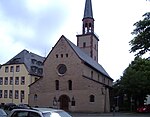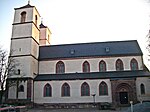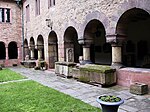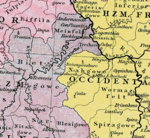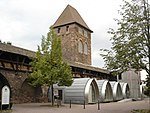Worms Cathedral

St Peter's Cathedral (German: Wormser Dom) is a Roman Catholic church and former cathedral in Worms, southern Germany. The cathedral is located on the highest point of the inner city of Worms and is the most important building of the Romanesque style in Worms. It is closely associated with Bishop Burchard and the high point of Worms' history in the 12th and 13th centuries. It was the seat of the Catholic Prince-Bishopric of Worms until its extinction in 1802, during German mediatisation. After the extinction of the bishopric, it was reduced in status to that of a parish church; however, it was bestowed the title of minor basilica in 1925 by Pope Pius XI. Most of the cathedral was finished by 1181, however the west choir and the vaulting were built in the 13th century, the elaborate south portal was added in the 14th century, and the central dome has been rebuilt. Great events associated with the cathedral include the nomination of Leo IX as Pope in 1048, the Concordat of Worms which ended the Investiture controversy in 1122, the marriage of Emperor Frederick II to Isabella of England in 1235 and the Diet of Worms in 1521, during which Martin Luther was condemned as a heretic.
Excerpt from the Wikipedia article Worms Cathedral (License: CC BY-SA 3.0, Authors, Images).Worms Cathedral
Schlossplatz,
Geographical coordinates (GPS) Address Phone number Website External links Nearby Places Show on map
Geographical coordinates (GPS)
| Latitude | Longitude |
|---|---|
| N 49.630277777778 ° | E 8.3597222222222 ° |
Address
Dom St. Peter
Schlossplatz
67547 , Worms-Zentrum (Innenstadt)
Rhineland-Palatinate, Germany
Open on Google Maps

